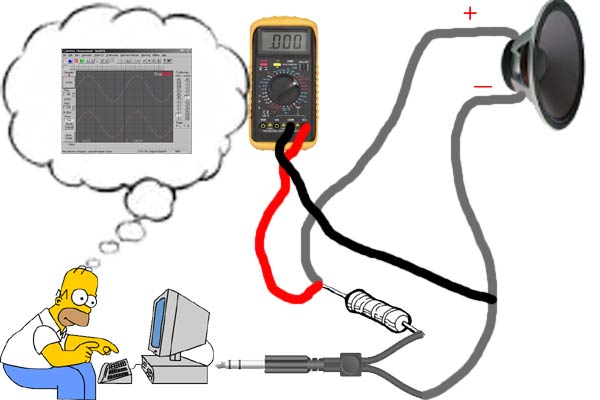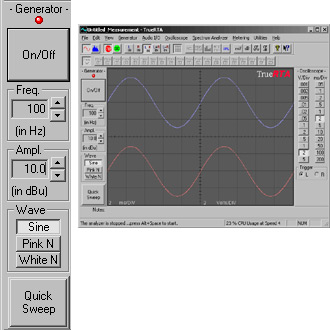How to verify speaker specs
You can not depend on manufacturers specifications. Even companies with the best intentions print bad information due to typos and incorrect data from their suppliers.
I have been testing loud speakers for years with complex, expensive equipment that is out of reach for the regular enthusiast. A couple of years ago I changed jobs and found myself working at a new company that did not have this equipment. Subsequently I found a need to verify specifications accurately with basic tools and next to no funds. I developed some reliable and simple methods of doing this. I am posting this because I have realized that this may be useful information to others.
To find resonant frequencies(fs) of any speaker including subs and tweeters:
You can even test for Fsb, and Fb for advanced study after the speakers have been installed in the vehicle.
The way that this works is, you use a laptop (or any PC) as a tone generator, and frequency counter. A cheap regular PC is capable of performing the same tests that 10's of thousands of dollars worth of dedicated equipment could do. You just need the software and the right connections.
The software is TrueRTA. And its FREE!!
The connections require a 3.5mm headphone jack, a single 5 watt 1k ohm resistor, and a true RMS digital multi meter. If you don’t have a True RMS multi meter, most likely someone you know does. Borrow it.
Here is how you make the connections.

Plug the 3.5mm into the speaker out of your PC. Cut the 3.5mm cable and insert the 1k resistor in line with the right positive conductor of the cable. The +and – of the left portion we will not be using. Connect the positive and negative ends to the speaker being tested.
Fire up TrueRTA. This program does a lot but we are only interested in the sine wave generator section that appears on the left hand side of the screen.

Set the frequency to a value that is close to the speakers Fs. Guess. Adjust the out put (labeled Ampl in the software) and the volume control on your PC until your meter reads 1V ac. Now scale the frequency up and down until you find the frequency that reads the maximum voltage value. This is your resonant frequency (Fs). Wasn’t that easy!
This only verifies one parameter, but it is one of the more important ones.
If this value is close to the one published by the manufacturer the you can assume with some amount of confidence that the other parameters are also likely correct.
If this value is off by more than 5hz compared to the advertised Fs assume that the rest of the information that the manufacturer has supplied you with is also false. Call the manufacturer and speak to a tech. Tell them that you tested Fs and it was not correct. Inquire about any version changes that might have taken place with this product, and compare your manufacture supplied information (specs) with his database (probably more current).
Always, always break in your speakers first! Fs will drop considerably. Google how to do this.
Use this method to check the Fs of your tweeters and mids. Set your active crossovers hi-pass to a minimum of twice the Fs value. never less.
After you build a vented enclosure you can verify Fb (tunning frequency) by running this test with the sub in the box.
 Printable version
Printable version












 Plug the 3.5mm into the speaker out of your PC. Cut the 3.5mm cable and insert the 1k resistor in line with the right positive conductor of the cable. The +and – of the left portion we will not be using. Connect the positive and negative ends to the speaker being tested.
Fire up TrueRTA. This program does a lot but we are only interested in the sine wave generator section that appears on the left hand side of the screen.
Plug the 3.5mm into the speaker out of your PC. Cut the 3.5mm cable and insert the 1k resistor in line with the right positive conductor of the cable. The +and – of the left portion we will not be using. Connect the positive and negative ends to the speaker being tested.
Fire up TrueRTA. This program does a lot but we are only interested in the sine wave generator section that appears on the left hand side of the screen.
 Set the frequency to a value that is close to the speakers Fs. Guess. Adjust the out put (labeled Ampl in the software) and the volume control on your PC until your meter reads 1V ac. Now scale the frequency up and down until you find the frequency that reads the maximum voltage value. This is your resonant frequency (Fs). Wasn’t that easy!
This only verifies one parameter, but it is one of the more important ones.
If this value is close to the one published by the manufacturer the you can assume with some amount of confidence that the other parameters are also likely correct.
If this value is off by more than 5hz compared to the advertised Fs assume that the rest of the information that the manufacturer has supplied you with is also false. Call the manufacturer and speak to a tech. Tell them that you tested Fs and it was not correct. Inquire about any version changes that might have taken place with this product, and compare your manufacture supplied information (specs) with his database (probably more current).
Always, always break in your speakers first! Fs will drop considerably. Google how to do this.
Use this method to check the Fs of your tweeters and mids. Set your active crossovers hi-pass to a minimum of twice the Fs value. never less.
After you build a vented enclosure you can verify Fb (tunning frequency) by running this test with the sub in the box.
Set the frequency to a value that is close to the speakers Fs. Guess. Adjust the out put (labeled Ampl in the software) and the volume control on your PC until your meter reads 1V ac. Now scale the frequency up and down until you find the frequency that reads the maximum voltage value. This is your resonant frequency (Fs). Wasn’t that easy!
This only verifies one parameter, but it is one of the more important ones.
If this value is close to the one published by the manufacturer the you can assume with some amount of confidence that the other parameters are also likely correct.
If this value is off by more than 5hz compared to the advertised Fs assume that the rest of the information that the manufacturer has supplied you with is also false. Call the manufacturer and speak to a tech. Tell them that you tested Fs and it was not correct. Inquire about any version changes that might have taken place with this product, and compare your manufacture supplied information (specs) with his database (probably more current).
Always, always break in your speakers first! Fs will drop considerably. Google how to do this.
Use this method to check the Fs of your tweeters and mids. Set your active crossovers hi-pass to a minimum of twice the Fs value. never less.
After you build a vented enclosure you can verify Fb (tunning frequency) by running this test with the sub in the box.




